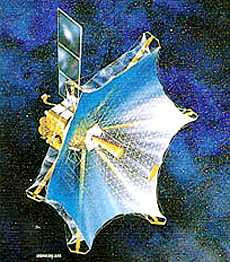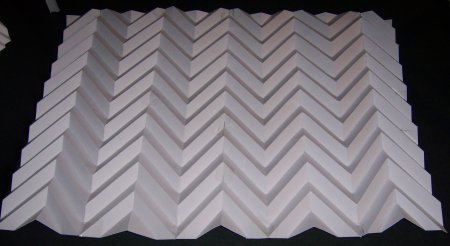on the property of property

Today’s post is about one of the rare examples where probably an artist made a discovery before the scientist did.
Unfortunately the discovery is linked to the problematic issue of patents and licences so that I need to speak about this issue again before talking about the discovery itself.
The interested randform reader may have noticed that I am a proponent of open access to information, thus I am against software patents and among others I think that this petition (which sofar received 26215 votes) should be signed. Likewise I think it is important to keep this issue up and running and to discuss it on a broad level. Moreover it is of significance to meet with like-minded people and exchange views on the matter. For a start. And I write “for a start” because I got the impression that these kind of discussions are still coming as something like a surprise to the math/physics community.
I.e. There has been made already some progress of how to treat the access problem to scientific information by for example setting up open access journals (an issue which got urgent with rising journal prices) and open course ware. However the problems and implications of licencing software have yet not been fully understood I find. This may be due to the fact that there are not so many mathematicians who work extensively with computers (besides using mathematica and latex), which is in principle OK since there are branches of math where a computer is not necessary. But sometimes even these branches may still be affected by the software discussion.
sideremark: For a similar reason I think it should be discussed how senseful patents – as a mean for funding research (thats what it is apriori) – are in general. Strangely enough the issue over patents is often linked to the question of (intellectual) property (making it sound as an ideological question) but isnt it more that patents are a remnant of the 19/20th century, where machines could be seen as rather simple entities and not as complicated interoperating objects (look at the current discussion about the patentability of genes)?
In the above mentioned randform post about software patents I was already talking about the example where a modified version of the Gauss-Newton Algorithm was patented. The discovery which I mentioned at the beginning of the post and about which I will write now is another example, where the math/physics culture°° is confronted with a difficult legal issue. (°°yes I will keep calling it a CULTURE even if e.g. Berlins biggest bookstore the Kulturkaufhaus has a collection of math/physics books which fits on 2 sqmeters :-O).
So here the discovery:
There exists a certain Origami folding which is called Miura (map) fold or Miura-ori (trademark) due to Prof. Koryo Miura of Tokyo University’s lnstitute of Space and Aeronautical Science who invented this particular origami pleat. Here is the Official Miura-Ori Site with an explanation about what’s a Miura fold. The particularity of the Miura fold is that one has to tear the paper only at one side and the paper unfolds. (see the animation in the feature and usage section on the official Miura-Ori Site). So this kind of pleating comes very handy e.g. for space applications where mechanical operations are costly. And hence the pleating technique of the Miura-Ori was used in the HALCA (Highly Advanced Laboratory for Communications and Astronomy), also known as MUSES-B before launch, which is an 8 meter diameter radio telescope satellite which was used for Very Long Baseline Interferometry (see above image).
Since there are costly technological improvements possible with this pleating technique it is no wonder that people were trying to gets licences/patents of all sort for it (patents/licence1/patents/licence2 on the official miura-ori site).
So what’s the problem with this?
Due to the paper:
Self-organized origami,
L. Mahadevan and S. Rica, Science, 307, 1740, (2005) I was suspecting that the Miura fold was a discrete integrable system. And in fact telling Tim about it he not only agreed in principle (there may degeneries occurring, this has to be excluded first), but moreover he explained that the Miura fold probably belongs to a whole class of one-parameter deformations which can be obtained via a discrete nonlinear sigma model together with a constraint. (details in the paper: W. K. Schief, A. I. Bobenko, and T. Hoffmann. On the integrability of infinitesimal and finite deformations of polyhedral surfaces Oberwolfach proceedings 2006**)
So shall these math authors now go on and try to licence their work? Shall the nonlinear sigma model be licenced ?! (:))
But thats not the only problem why I think licensing in connection with the Miura fold is problematic. There may be yet another problem with it: – May be I am wrong- but it looks as if someone else had already found the Miura fold about 50 years before Kyoro Miura did. And this was probably the artist Josef Albers and/or a pupil of him.
Why do I think so?
Well on my trip to the Bauhaus I visited the little exhibition in the Bauhaus. It was forbidden to take fotographs in the exhibition, but what I saw there made me disobey and so I took the below forbidden fotographs:

info underneath the fold
There exists also an old vintage photograph of the fold (also in the exhibition).
I wrote into the guest book of the Bauhaus exhibition about the connection to the Miura fold and that it is used in space missions (solar panels and sails) and I mentioned the licences. In addition I left a little letter at the Bauhaus exhibitions cashiers desk with my email adress. I must have made a sick impression at the cashiers desk – the woman there looked at me a bit as if I was mad. May be thats why I haven’t got any reply from the Bauhaus. So concluding: I am neither sick nor mad (knock on wood) – I just think that the information I left at the Bauhaus may be valuable information for the Bauhaus and/or the heritage of Josef Albers. Thats it (and I hope they forgive me the forbidden photograph).
-So can any of the design people which are reading this blog please inform the Bauhaus again? I feel that I can’t do much more at the moment about this (besides writing about it here). Its up to them.
**the Oberwolfach proceedings are not open access.
September 7th, 2007 at 6:11 pm
Nice blog! A very minor pedantic comment: the word “senseful” should be “sensible”.
A more interesting question (I hope): can you sketch the sense in which the Miura fold is an integrable system? Do you mean there’s some differential equation describing “Miura folds”, which is an integrable system?
September 8th, 2007 at 11:26 am
John,
If you look at a quadrilateral lattice with planar faces you can ask the question: what are the conditions that the lattice posseses a (finite) deformation that keeps all the faces in shape (an isometric deformation). You will end up with equations for the normals of the faces only.
Knowing the normals gives you the directions of the edges as well. Thus, if a lattice is deformable all lattices made of quadrilaterals with parallel edges (for corresponding quads) will be deformable as well (they are called Combescure transforms).
It is easy to see that in general such a quadrilateral mesh admits at most a one parameter freedom for deformations (so in a sense the Miura folds are degenerate since in the planar limit you may choose not to fold in the “Miura-direction” but along the straight lines. However, as long as the configuration is not completely planar you will indeed have only one freedom)
The normals are governed by a discrete zero curvature condition.The corresponding linear matrix system has a spectral parameter wich can be viewed as the deformation parameter.
Another formulation would be the normals of a deformable lattic correspond to one-parameter-families of solutions to a discrete nonlinear sigma model in the lightcone of a Minkowski R^5 such that the first three components are constant in the family.
The discrete nonlinear sigma model is a well known discrete integrable system and roughly speaking it describes here the “evolution” of the normals along the lattice and not the deformation (or folding) itself.
The folding “sits” in the spectral parameter and is not itself described as a differential equation.
The difference equations describe more or less the normals that allow for a deformation.
timh